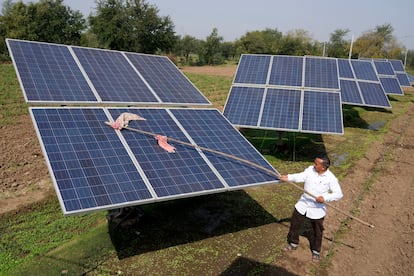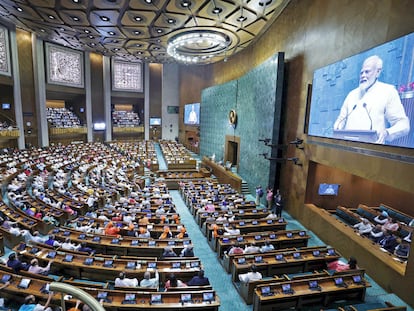India pauses plans to add new coal plants for five years. Now it bets on renewables and batteries
India is the world’s third highest emitter and most populous country. It plans to reach net zero emissions by 2070, which would mean significantly slashing coal use and ramping up renewable energy

The Indian government will not consider any proposals for new coal plants for the next five years and focus on growing its renewables sector, according to an updated national electricity plan released Wednesday evening.
The temporary pause in the growth of the dirty fuel was hailed by energy experts as a positive step for a country that is currently reliant on coal for around 75% of its electricity.
Updated every five years, the plan serves as a guideline for India’s priorities in its electricity sector.
In a draft of the plan released in September, the Central Electricity Authority, which is in charge of planning for India’s electricity needs, projected that nearly 8,000 megawatts of new coal capacity was required by 2027. But Wednesday’s strategy proposes the build out of more than 8,600 megawatts of battery energy storage systems instead.
Battery storage is crucial for round-the-clock use of renewable energy.
“This plan is a step in the right direction,” said Raghav Pachouri, an energy sector expert at Vasudha Foundation, a New Delhi-based think tank.
Pachouri said one reason the plans for new coal might have been scrapped is because there are already some coal plants under construction.
The country is also experiencing longer summers and hotter weather in part due to climate change, meaning greater electricity demand during the scorching day, making it easier to fulfill energy needs with renewables, said Pachouri.
“When you need energy during the day, solar power can provide for it,” he said.
India plans to install 500 gigawatts of clean energy by 2030, enough energy to power anywhere from 150 to 500 million homes depending on power use, but is not on course to meet that target, according to Aditya Lolla, an energy analyst at the think tank Ember.
“We’re installing only up to 17 gigawatts a year, this needs to increase to 40 to 45 gigawatts to meet targets,” said Lolla.
The new plan goes on to project that new coal power will be built after 2027, but Lolla says this should be taken with a pinch of salt.
“Traditionally, projections for the coming five years are more concrete and those for the subsequent years are essentially placeholders,” said Lolla. “India wants to move towards a cleaner power system. With every electricity plan, the coal pipeline is falling.”
Lolla predicts that with the current volatile global energy picture, due to Russia’s war in Ukraine, climate change and pandemic recovery, India will take a call on its longer-term energy plan at a future date, depending on how things progress by 2027.
Sign up for our weekly newsletter to get more English-language news coverage from EL PAÍS USA Edition
Tu suscripción se está usando en otro dispositivo
¿Quieres añadir otro usuario a tu suscripción?
Si continúas leyendo en este dispositivo, no se podrá leer en el otro.
FlechaTu suscripción se está usando en otro dispositivo y solo puedes acceder a EL PAÍS desde un dispositivo a la vez.
Si quieres compartir tu cuenta, cambia tu suscripción a la modalidad Premium, así podrás añadir otro usuario. Cada uno accederá con su propia cuenta de email, lo que os permitirá personalizar vuestra experiencia en EL PAÍS.
¿Tienes una suscripción de empresa? Accede aquí para contratar más cuentas.
En el caso de no saber quién está usando tu cuenta, te recomendamos cambiar tu contraseña aquí.
Si decides continuar compartiendo tu cuenta, este mensaje se mostrará en tu dispositivo y en el de la otra persona que está usando tu cuenta de forma indefinida, afectando a tu experiencia de lectura. Puedes consultar aquí los términos y condiciones de la suscripción digital.
More information
Archived In
Últimas noticias
The new victims of the Republican war on Obamacare: Millions hit by soaring health insurance premiums
A country divided on migrant rights: Some US states expand protections while others restrict them
Venezuela authorizes the release of another 87 political prisoners
There is as much life left to discover on planet Earth as that which is already known
Most viewed
- David King, chemist: ‘There are scientists studying how to cool the planet; nobody should stop these experiments from happening’
- Reinhard Genzel, Nobel laureate in physics: ‘One-minute videos will never give you the truth’
- Oona Chaplin: ‘I told James Cameron that I was living in a treehouse and starting a permaculture project with a friend’
- Sinaloa Cartel war is taking its toll on Los Chapitos
- The Interoceanic Train, the Mexican alternative to the Panama Canal










































